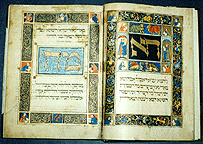



The Haggadah, which recounts the Jews' exodus from Egypt (Book of Exodus), is the Hebrew book which is used during the Passover Seder (meal). The word Haggadah means literally "narration" or "the telling of a story". The Haggadah contains an explanation of the Seder plate as well as the various songs and hymns which pertain to this festival. Specifically, the book focuses on answering the four question which are posed at the beginning of the Seder. Typically asked by the youngest child attending the Seder, they include the following: 1) On all other nights we eat either leavened bread or (matzah) unleavened; on this night why only unleavened bread? 2) On all other nights we eat herbs of any kind; on this night why only bitter herbs? 3) On all other nights we do not dip our herbs even once; on this night why do we dip them twice? 4) On all other nights we eat our meals in any manner; on this night why do we sit around the table together in a reclining position?
The majority of the Haggadah text was written during the First Temple period. Additions continued to be made, however, until the 13th century. Since that time, many editions of the Haggadah have been printed. Among Jewish households today, the Haggadah is probably the most widely-held religious text.
| Back to Glossary | Jewish Holidays | Treasures | Life Cycle | Home Page |